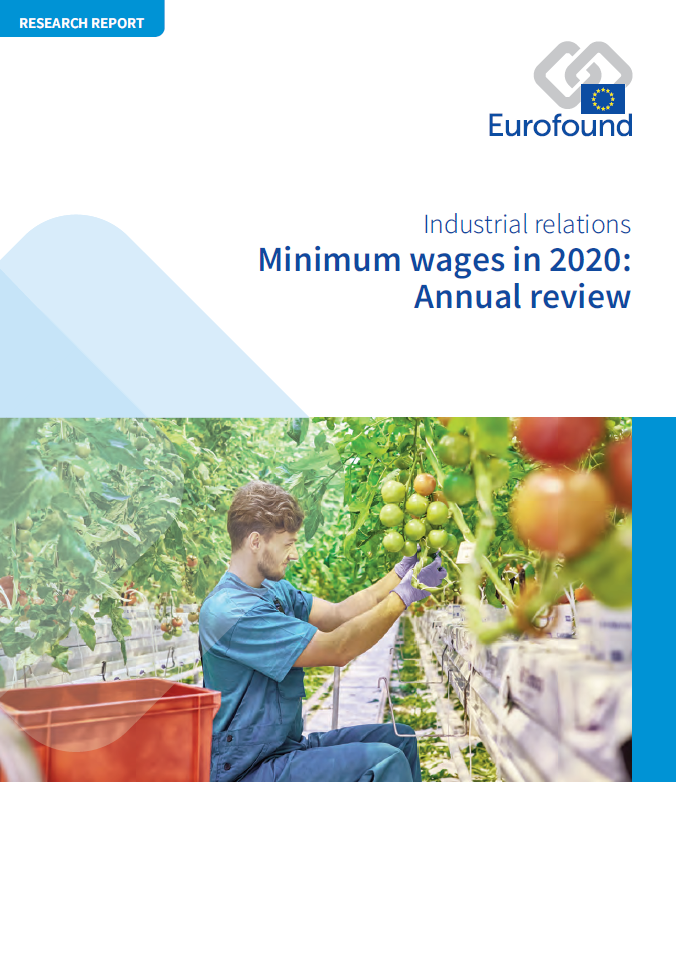
Táto správa, ktorá je súčasťou každoročnej série správ o minimálnych mzdách, zhŕňa hlavný vývoj počas roku 2019 a začiatkom roku 2020 v súvislosti s iniciatívou EÚ v oblasti spravodlivých miezd. V tomto kontexte nastoľuje aj vnútroštátnu diskusiu o stanovovaní sadzieb na rok 2020 a na nasledujúce obdobie. V správe sa predstavuje spôsob stanovovania minimálnych miezd a úloha, ktorú zohrávajú sociálni partneri. Rozoberá sa v nej vývoj v oblasti zákonných minimálnych miezd a v prípade krajín, ktoré takéto mzdy nemajú, sa uvádzajú údaje o sadzbách minimálnej mzdy v kolektívnych zmluvách s ohľadom na desať slabo platených pracovných miest. Správa obsahuje aj oddiel venovaný regionálnemu rozmeru minimálnych miezd a predstavuje sa v nej najnovší výskum vplyvov zmien minimálnej mzdy na mzdy, zamestnanosť, chudobu pracujúcich, ceny a zisky.
Key findings
V roku 2019 sa v mnohých krajinách diskutovalo o ďalšom podstatnom zvyšovaní minimálnej mzdy po roku 2020, čiastočne vo vzťahu k relatívnemu cieľu, čiastočne v absolútnom vyjadrení.
Zákonné minimálne mzdy sú od začiatku tisícročia v porovnaní so mzdami ostatných pracovníkov spravodlivejšie (ak sa porovnávajú základné minimálne mzdy s mediánom mzdy všetkých pracovníkov).
Napriek tomuto stúpajúcemu trendu zostávajú minimálne mzdy vo väčšine krajín pod úrovňou 60 % či dokonca pod úrovňou 50 % mediánu mzdy. Platí to najmä v prípade členských štátov v strednej a vo východnej Európe, ktoré na začiatku tisícročia začínali na mimoriadne nízkych relatívnych úrovniach a vo svojich právnych predpisoch týkajúcich sa minimálnej mzdy majú aj naďalej ciele približne na úrovni alebo pod úrovňou 50 %.
Celkovo 7 z 10 pracovníkov s minimálnou mzdou uvádza, že majú prinajmenšom určité ťažkosti vystačiť si príjmom, v porovnaní s menej ako 5 z 10 ostatných pracovníkov. Tieto číselné údaje sa však v rámci jednotlivých krajín značne líšia. V Dánsku, vo Fínsku, v Nemecku a vo Švédsku to považuje za náročné až veľmi náročné menej ako 10 % pracovníkov s minimálnou mzdou, zatiaľ čo v Bulharsku, Chorvátsku a na Cypre má takéto ťažkosti 50 % až 60 % a v Grécku 80 % pracovníkov.
Vlády v celej Európe reagujú opatreniami na stabilizáciu príjmov osôb, ktoré sú zasiahnuté krízou vyvolanou ochorením COVID-19. V kombinácii politík môžu minimálne mzdy zohrávať úlohu zameranú na stabilizáciu príjmov, a tým aj dopytu s cieľom vyvážiť klesajúci trend vedúci k recesii alebo depresii.
Data
Find data on statutory minimum wages in the EU.
- Data: Proportion of minimum wage workers who find it difficult to make ends meet, EU average
- Data: Minimum wage developments in real terms, 15 euro area countries, 2015 price levels
- Data: Proportion of minimum wage workers who find it difficult to make ends meet
- Data: Statutory minimum wages - Minimum wages in the EU in 2020
List of tables
- Table 1: Social partners’ first reactions to the announced initiative on fair wages
- Table 2: Overview of main arguments and proposals concerning an EU minimum wage initiative from social partners
- Table 3: Gross minimum wages, selected EU Member States and the UK, 2019 and 2020
- Table 4: Sub-minimum rates for selected EU Member States and the UK as at 1 January 2020
- Table 5: Further statutory minimum wage rates for private sector workers in selected EU Member States
- Table 6: Number of collective agreements covering low-paying job categories for countries without statutory minimum wages
- Table 7: Minimum wages in collective agreements, applicable in 2019 for selected low-paid jobs
- Table 8: Collective agreement coverage in Finland
- Table 9: Overview of debates during 2019 on aspects of the minimum wage setting processes
- Table 10: Demands for and agreements on targets for future minimum wages to address adequacy in selected EU Member States and the UK
- Table 11: Regional statutory minimum wage rates
- Table 12: Latest minimum wage research in EU Member States and the UK
- Table 13: Overview of recent empirical research in the EU, Norway and the UK on employment impacts of minimum wage increases, 2019
- Table 14: Policies influencing in-work poverty
- Table A1: Network of Eurofound Correspondents – Members participating in the research
List of figures
- Figure 1: Conceptualising adequate minimum wages
- Figure 2: Estimated share of employees earning 90% to 110% of the minimum wage, EU Member States, 2017
- Figure 3: Proportions of female and male employees, EU level, 2017
- Figure 4: Proportion of minimum wage workers per sector, EU level, 2017
- Figure 5: Proportion of minimum wage workers per occupation (top 10), EU level, 2017
- Figure 6: Hourly minimum wages, selected EU Member States, 2020
- Figure 7: Minimum wage developments in real terms, 15 euro area countries, 2015 price levels
- Figure 8: Minimum wage developments in real terms, non-euro area, 2015 price levels
- Figure 9: Impact of purchasing power on the minimum wage value for selected EU Member States and the UK, as at 1 January 2020
- Figure 10: Relative distance between purchasing power of lowest and median minimum wage EU Member States and the UK and highest minimum wage EU Member States and the UK, 2010–2020
- Figure 11: Process for determining minimum wage rates for 2020
- Figure 12: Number of minimum wage rate updates, EU Member States with statutory minimum wages and the UK, since 2010
- Figure 13: Longer-term trend of development of statutory minimum wages relative to median wages of full-time employed workers, selected countries within the EU and the UK, 2000–2018
- Figure 14: Proportion of minimum wage workers who find it difficult to make ends meet, EU average
- Figure 15: Proportion of minimum wage workers who find it difficult to make ends meet
- Figure 16: Making ends meet and minimum wages in relative and absolute terms
- Figure 17: Monthly minimum wage as a proportion of the mean value of average monthly earnings by NUTS1 region, reference year 2016
- Figure 18: Regional variation of relative monthly minimum wages, by NUTS1 region, 2016
- Figure 19: Examples of countries with higher interregional differences in the proportion of minimum wage workers
- Number of pages
-
86
- Reference nº
-
EF20005
- ISBN
-
978-92-897-2068-7
- Catalogue nº
-
TJ-AS-20-001-EN-N
- DOI
-
10.2806/999852
- Permalink
Cite this publication
